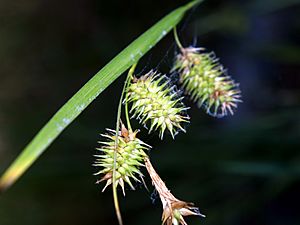Bottlebrush sedge facts for kids
Quick facts for kids Bottlebrush sedge |
|
|---|---|
 |
|
| Scientific classification |
Carex hystericina is a type of plant called a sedge. It's often known by its fun common names: bottlebrush sedge or porcupine sedge. These names come from the way its flower clusters look, a bit like a bottle brush or a porcupine's quills!
Contents
Where Does Bottlebrush Sedge Live?
This sedge grows naturally across a large part of North America. You can find it in most of southern Canada and almost all of the United States.
It loves to grow in wet places. Think of wetlands, swamps, and along the banks of rivers and streams. It especially likes soil that has a lot of limestone in it, which is called "calcareous soil." If the conditions are just right, it can grow very quickly and spread a lot, sometimes even becoming quite common in an area.
What Does Bottlebrush Sedge Look Like?
Bottlebrush sedge grows in clumps. Its stems can reach up to one meter (about 3 feet) tall. What's cool is that its stems are shaped like triangles!
This plant spreads using short underground stems called rhizomes. These rhizomes help new plants grow nearby.
Its flowers grow in a cluster called an inflorescence. This cluster can be several centimeters long. There's also a special leaf, called a bract, that grows near the flowers. This bract is usually longer than the flower spikes themselves.
After the flowers, tiny fruits develop. Each fruit is covered in a protective case called a perigynium. These cases have pointy, toothed tips, which is why some people think they look like porcupine quills!
Why Is Bottlebrush Sedge Important?
Because bottlebrush sedge grows so well in wet areas, it's often used in projects to help bring back natural sedge meadows. These projects are called "restorations." By planting this sedge, people can help create healthy wetland habitats for many other plants and animals.
See also
 In Spanish: Carex hystericina para niños
In Spanish: Carex hystericina para niños

